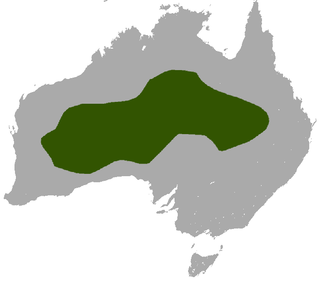
Gould's mouse, also known as the Shark Bay mouse and djoongari in the Pintupi and Luritja languages, is a species of rodent in the murid family. Once ranging throughout Australia from Western Australia to New South Wales, its range has since been reduced to five islands off the coast of Western Australia.

Pseudomys is a genus of rodent that contains a wide variety of mice native to Australia and New Guinea. They are among the few terrestrial placental mammals that colonised Australia without human intervention.

The Wongai ningaui is a tiny carnivorous marsupial native to the arid open grasslands of inland Australia. Their diet is mainly small insects, and occasionally larger prey such as spiders, grasshoppers and cockroaches, which they forage for at the ground and in clumps of spinifex. They have long and untidy fur, grey or gingery brown with longer black hairs, small ears, a narrow muzzle, and possess a partially prehensile tail and feet that allow them to climb. The population occurs sparsely across a wide area and common in favourable habitat, especially in years of good rainfall. Ningaui ridei was first described in 1975, one of two species of a new genus discovered amongst the poorly known mammals of the western regions of Australia.

The northern or sandy nail-tail wallaby is a species of macropod found across northern Australia on arid and sparsely wooded plains. The largest species of the genus Onychogalea, it is a solitary and nocturnal herbivorous browser that selects its food from a wide variety of grasses and succulent plant material. Distinguished by a slender and long-limbed form that resembles the typical and well known kangaroos, although their standing height is shorter, around half of one metre, and their weight is less than nine kilograms. As with some medium to large kangaroo species, such as Osphranter rufus, they have an unusual pentapedal motion at slow speeds by stiffening the tail for a fifth limb. When fleeing a disturbance, they hop rapidly with the tail curled back and repeatedly utter the sound "wuluhwuluh". Their exceptionally long tail has a broad fingernail-like protuberance beneath a dark crest of hair at its end, a peculiarity of the genus that is much broader than the other species. The name unguifera, meaning claw, is a reference to this extraordinary attribute, the purpose of which is unknown.

Nabarleks, are a tiny species of macropod found in northern Australia. They are a shy and nocturnal animal that resides in rocky hollows and forages in the surrounding area. Their diet is grasses, sedges, and ferns found in and around their scrub covered refuges. They are distinguished by a reddish tinge to the mostly grey fur and a distinct stripe at the cheek. They move with great speed and agility when observed, with a forward leaning posture and a bushy tail that arches over the back.

The heath mouse is a species of mouse in the subfamily Murinae, the Old World rats and mice, found in Australia.

The fawn-footed mosaic-tailed rat, or fawn-footed melomys is a species of rodent in the family Muridae. It is found along eastern coastal regions of Australia.

Bolam's mouse is a species of nocturnal, burrowing rodent in the family Muridae that inhabits the semi arid and southern arid regions of Australia. It has a number of physiological and behavioural adaptations developed to cope with an extremely varied climate. Including the ability survive by extracting water from seeds alone, the production of highly concentrated urine, low water content faeces and nocturnal activity.

The desert mouse, also known as the brown desert mouse, is a species of rodent in the family Muridae. It is endemic to Australia. The first desert mouse specimen was collected by Australian zoologist Gerard Krefft on the Blandowski Expedition in 1856-57, between Gol Gol Creek and the Darling River.
The blue-gray mouse is an Australian rodent species that is only known by a few specimens found in Eastern Australia, and since presumed to have become extinct.

The sandy inland mouse is a species of rodent in the family Muridae. Also known as the Hermannsburg (Mission) false-mouse or Hermannsburg mouse, it is endemic to Australia and found widely yet sparsely through arid and semi-arid areas.

The western mouse or walyadji is a species of rodent in the family Muridae. Once widespread across a larger range, it has become restricted to around ten reserves of remnant bushland in Southwest Australia and declared near threatened by extinction. They are small and robust mice that live in burrows in sandy soil, venturing out at night to forage in nearby area.

Hydromyini is a very large, diverse tribe of muroid rodents in the subfamily Murinae. They are the dominant native rodents in Australasia and one of only two native rodent groups there, the other being the R. fuscipes group of the genus Rattus in the tribe Rattini. They are also found in parts of Southeast Asia.













